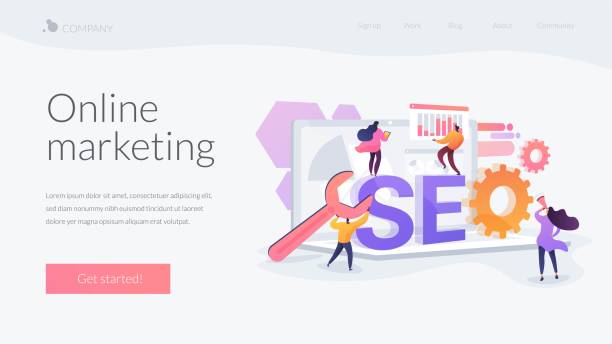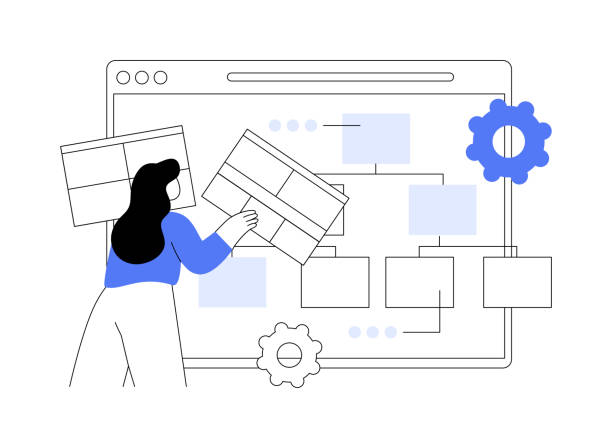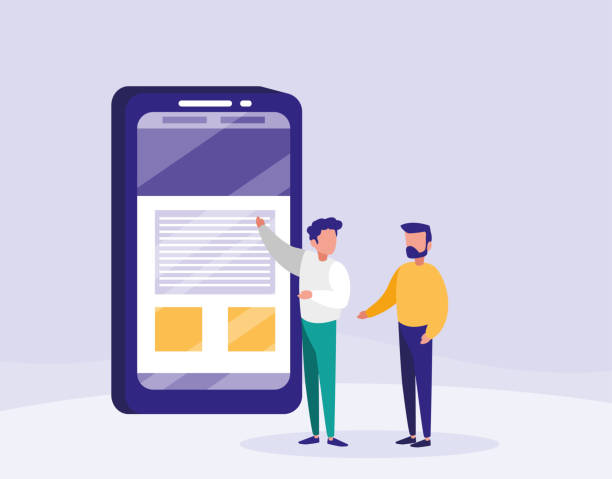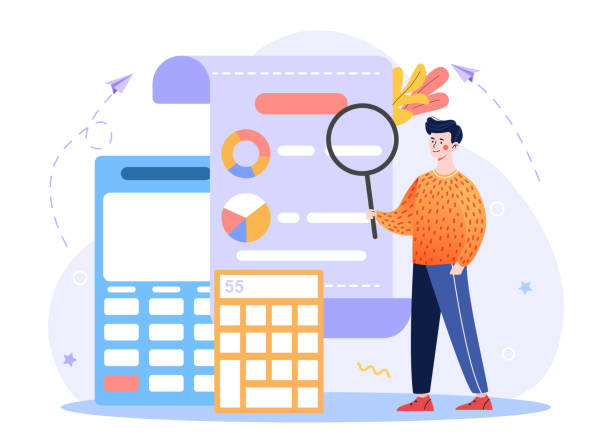Introduction to User-Friendly Website Design and Its Importance

In today’s digital world, where competition for user attention intensifies moment by moment, the concept of “User-Friendly Website Design” is no longer a luxury option but a vital necessity.
A successful website does not rely solely on its aesthetic appeal; rather, it must provide a seamless, enjoyable, and efficient experience for its visitors.
This website design goes beyond element arrangement and delves into user psychology to meet their needs and expectations.
The main goal of user-friendly website design is to reduce friction and obstacles for the user, allowing them to quickly and easily access the information or services they need without confusion.
In this educational section, we address the thought-provoking content of why your website should be designed for users and not just for search engines.
A website with a poor user experience, even with rich content and strong SEO, cannot convert users into customers or encourage them to return.
#UserExperience #UserFriendlyWebsite #SEO #WebsiteDesign In fact, poor user experience (UX) increases the Bounce Rate and ultimately affects your site’s ranking in search engines.
Therefore, user-friendly website design is directly related to the success of your online business.
Understanding these fundamental principles is the first step towards building a powerful digital platform that can best achieve your business goals.
Do you really believe your website can survive in the vast ocean of the internet without considering user convenience? This is where the importance of user-centric website design becomes apparent.
One of the most important aspects of user-friendly website design is its Accessibility for all individuals, regardless of their abilities or the device they use.
This approach is not only ethical but also covers a larger market of users.
A standard and accessible website demonstrates your respect for the audience.
Furthermore, website loading speed and responsiveness are key factors in a positive user experience.
Studies have shown that users expect a page to load in less than three seconds, otherwise, the likelihood of abandoning the site significantly increases.
Therefore, focusing on speed optimization is also an integral part of user-friendly website design.
Is your company’s website as professional and trustworthy as it should be? With specialized corporate website design by Rasawweb, create an online presence that reflects your credibility and attracts more customers.
✅ Build a powerful and professional image for your brand
✅ Convert visitors into real customers
⚡ Get a free consultation now!
Key Principles of User Experience (UX) and User Interface (UI)

To achieve user-friendly website design, it is necessary to become familiar with the fundamental concepts of User Experience (UX) and User Interface (UI).
These two concepts, though often confused, are complementary, and both are essential for creating a website with an excellent user experience.
User Interface (UI) refers to the look and feel of a website; it includes colors, fonts, the arrangement of buttons and forms, and generally everything the user sees and interacts with.
In contrast, User Experience (UX) goes beyond appearance and deals with how the user feels when using the site; is navigation easy? Is information easily found? Does the website meet the user’s needs?
A user-friendly website design is achieved by adhering to specialized UX/UI principles.
Among these principles are Simplicity, Consistency, and Feedback.
Simplicity means removing unnecessary elements and providing a minimalist design that focuses the user’s attention on the main content.
This principle, in the guidance section, helps us avoid clutter and unnecessary complexities.
Consistency in design means maintaining uniformity in colors, fonts, icons, and the behavior of elements across the entire website.
This helps users navigate different parts of the site easily without needing to relearn.
Feedback refers to informing the user about their actions, for example, after clicking a button or submitting a form.
In this specialized section, it is emphasized that success in user-friendly website design requires a deep understanding of user behavior.
The UX design process often begins with user research, which includes interviews, surveys, and data analysis to understand the target audience.
Afterward, wireframes and prototypes are created to test initial design ideas before final coding.
This iterative approach allows designers to identify and resolve potential issues before the final launch.
Remember that a website with an excellent user experience provides a clear and unobstructed path for the user to achieve their goals.
Therefore, investing in user-friendly website design is an investment in the long-term success of your online business.
Attention to visual hierarchy is also of high importance.
This means arranging elements in a way that the most important information and actions attract the most attention.
Using white space, appropriate contrast, and different font sizes can help guide the user’s eye on the page.
A user-friendly website design invites the user on a guided and logical journey.
These principles apply not only to new websites but are also vital for improving and redesigning existing sites.
The Importance of Responsiveness in User-Friendly Website Design

In the current era, where users access the internet from various devices including smartphones, tablets, and desktops, Responsive Web Design has become a fundamental principle in user-friendly website design.
Responsiveness means a website’s ability to automatically adapt to the screen size and characteristics of the user’s device, without needing to zoom, horizontal scroll, or lose content.
This approach ensures a seamless and optimized experience on any device and is a significant part of user-centric website design.
This educational and analytical section shows why ignoring responsive design can mean losing a significant portion of your audience.
Given that a large percentage of internet traffic comes from mobile devices, a website that does not display well on mobile practically loses half of its market.
User-friendly website design includes ensuring that the user experiences the same quality and ease of access on any device.
Also, search engines like Google prefer responsive websites in their rankings, which is a strong reason to implement it.
Below is a comparative table of different design approaches for mobile devices to provide a better understanding of the subject:
| Feature | Responsive Design | Adaptive Design | Separate Mobile Site |
|---|---|---|---|
| Definition | A single layout that adapts to any screen size. | Multiple fixed layouts for specific screen sizes. | A completely separate website (m.example.com). |
| Implementation | Uses CSS Media Queries and Fluid Grids. | Detects device type and serves appropriate layout. | Maintains two independent websites. |
| SEO Optimization | Recommended by Google, same URL. | Same URL, requires server configuration. | Requires Canonical Tags and precise Redirects. |
| Ease of Maintenance | Relatively easy, one codebase. | Moderate, multiple layouts to maintain. | Difficult, maintaining two sites. |
A user-friendly website design that adopts a responsive approach not only improves the user experience but also simplifies the development and maintenance process.
This approach allows us to ensure the correct display of the website on various devices with a single codebase, which is a great advantage in terms of cost and time.
Investing in user-friendly website design with a focus on responsiveness means investing in the future of your online business.
Ignoring it can mean falling behind competitors.
Visual Navigation Design and Information Architecture

One of the main pillars of user-friendly website design is visual and intuitive Navigation Design and Information Architecture.
Good navigation helps users quickly and without confusion find the content they are looking for on the website.
This includes the structure of menus, internal links, the search bar, and page hierarchy.
Information architecture is the organization and labeling of content in a logical and understandable manner that aligns with user expectations.
A website with an excellent user experience provides clear and logical navigation for users.
In this specialized and guidance section, the importance of simplicity and clarity in navigation design is emphasized.
Complex menus filled with unnecessary options can confuse users and force them to leave the site.
User-friendly website design requires navigation options to be as concise, expressive, and predictable as possible.
Using clear and familiar terms instead of business-specific jargon significantly improves usability.
For example, instead of using ambiguous phrases, use words like “About Us”, “Services”, “Products”, and “Contact Us”.
Elements key to effective navigation include:
- Primary Navigation: Should be placed in a fixed and visible location (usually at the top or side of the page) and include main links to the most important sections of the site.
- Secondary Navigation: Used for subsections of each primary menu option.
- Search Bar: Essential for websites with a lot of content so users can quickly find the information they are looking for.
Its location should be accessible, and its icon (usually a magnifying glass) should be universal. - Breadcrumbs: These small navigation paths show the user where they are on the site and how they can return to higher-level pages.
This feature is very useful for improving user-friendly website design. - Footer Navigation: Includes links to less important pages such as privacy, terms and conditions, and social media links.
A user-centric website design pays special attention to information hierarchy.
This means that website content should be logically grouped and categorized so that the user can easily move from generalities to specifics.
Using clear headings (H1, H2, H3), ordered and unordered lists, and short paragraphs all help improve readability and content comprehension.
The ultimate goal of user-friendly website design in this area is to reduce cognitive load on the user and facilitate their goal achievement.
Can your users easily navigate from one point to another on your website? The answer to this question is the key to your navigation’s success.
Does your company’s website perform as befits your brand? In today’s competitive world, your website is your most important online tool. Rasawweb, a specialist in professional corporate website design, helps you to:
✅ Gain customer credibility and trust
✅ Convert website visitors into customers
⚡ Get a free consultation!
Content Strategy for Greater User Engagement

Content is the beating heart of any website, but merely having a lot of content is not enough.
To achieve user-friendly website design, content must not only be valuable and relevant but also presented in a way that is engaging, understandable, and interactive for users.
Content strategy means planning for the creation, publication, and management of content that aligns with business goals and user needs.
This approach forms the core of a user-centric website design.
In this explanatory and entertaining section, we discuss the importance of content that is easy to read.
Long texts without visual breaks can tire users.
Using short paragraphs, engaging headings, bulleted lists, and sufficient white space all help improve readability.
Additionally, thought-provoking content, or content that encourages users to think, can significantly increase engagement.
For example, asking a question at the end of an article or inviting comments engages users.
Key elements of an effective content strategy for user-friendly website design include:
- Clarity and Conciseness: Use simple and understandable language and avoid using specialized jargon, unless your audience is also specialized.
- Relevance: Content must directly address the needs, questions, and interests of your target audience.
- High Readability: As mentioned, using headings, subheadings, lists, and short paragraphs increases readability.
- Use of Images and Videos: Visual content can convey complex concepts in a simple and engaging way.
Images, infographics, and videos play an important role in attracting and retaining user attention. - Call to Action (CTA): Every page and piece of content should have a clear goal and encourage users to perform an action (purchase, sign-up, download, contact, etc.).
CTAs should be clear, specific, and prominent.
A website with an excellent user experience provides content that is not only informative but also encourages users to stay and explore more on the site.
User-friendly website design in terms of content means creating a story that connects with the user.
Your content should answer potential user questions, solve their problems, and ultimately guide them towards your business goals.
Remember that today’s users don’t have much time; your content must quickly demonstrate its value.
By implementing these approaches, you can ensure that your website is not only seen but also memorable.
The Role of Visual Design and Branding in User Attraction

Visual design and branding are vital elements in user-friendly website design that go beyond mere aesthetics.
They shape your website’s identity and influence the user’s perception, feeling, and interaction with your brand.
A strong visual design, consistent with the brand, not only makes the website more appealing but also adds to its credibility and professionalism.
This aspect of user-centric website design helps create a first impression and ultimately user loyalty.
In this specialized and entertaining section, we discuss the key elements of visual design.
Colors play an important role in creating mood and conveying messages.
Choosing the right color palette that matches your brand identity and is effective in terms of color psychology can significantly improve the user experience.
For example, blue colors typically convey a sense of trust and professionalism, while green colors can evoke a sense of nature and growth.
Typography (Font) is another important factor in user-friendly website design.
Choosing readable fonts appropriate for your brand not only enhances aesthetics but also significantly aids content readability.
Using too many or inappropriate fonts can make the website appear cluttered and unprofessional.
Consistency in font usage throughout the site, contributes to visual cohesion.
Images and videos must also be high-quality and relevant to the content.
Using low-quality or irrelevant stock images can negatively impact the user’s perception of your brand.
Investing in professional photography or using custom graphics can make a significant difference in attracting and retaining user attention.
Also, white space (Whitespace) or negative space, which is the empty space between design elements, plays a vital role in user-friendly website design.
This space allows the user’s eye to rest and gives important elements more prominence.
Finally, integrated branding means that every aspect of the website, from the logo and colors to the tone of writing, must reflect your brand’s message and values.
This consistency in branding helps build recognition and trust among users and makes your site memorable in their minds.
A user-friendly website design must not only be beautiful but also effectively showcase your brand and establish a deep connection with your target audience.
It is this emotional and visual connection that converts users into loyal customers.
Website Performance and Accessibility Optimization

Performance optimization and accessibility are two critical aspects of user-friendly website design that are often overlooked, but have a significant impact on overall user experience and website success.
Website loading speed not only affects user satisfaction but is also an important factor in search engine rankings (SEO).
In contrast, accessibility ensures that your website is usable by all users, including those with disabilities.
These two factors are among the main pillars of a user-centric website design.
In this analytical and news section, we discuss methods for improving performance and accessibility.
A slow website can quickly lead to user loss.
Studies show that most users leave a site if it is slow.
To increase speed, you can use image compression, caching, code optimization (CSS, JavaScript), and choosing a reliable hosting provider.
Tools like Google PageSpeed Insights can help you identify problems and provide solutions for improvement.
Below, a table of common performance issues and their solutions is provided:
| Performance Issue | Description | Solution |
|---|---|---|
| Large and Unoptimized Images | Images with high dimensions and file sizes increase loading time. | Image compression, use of optimized formats (WebP), Lazy Loading. |
| Uncompressed CSS and JavaScript Files | Uncompressed code files take up a lot of space. | Minification of code, combining files, using CDN. |
| Inadequate Hosting | Server speed and hosting quality directly impact response time. | Choosing high-quality hosting, upgrading hosting plan. |
| Lack of Caching | Caching stores repetitive information and speeds up subsequent visits. | Activating server-side and browser-side caching. |
Regarding accessibility, user-friendly website design means that people with disabilities (visual, auditory, motor, and cognitive) can also easily use your website.
This includes using alternative text (Alt Text) for images, captions for videos, keyboard-accessible navigation, and appropriate color contrast.
Adhering to WCAG (Web Content Accessibility Guidelines) standards not only helps improve the user experience for everyone but is also legally important in many countries.
An accessible website demonstrates your commitment to inclusivity and respect for all users.
Investing in these areas is a strategic investment for the future of your website.
User Testing and Continuous Feedback

No matter how much your user-friendly website design is based on principles and best practices, until you test it with real users, you cannot be sure of its ultimate success.
User Testing and continuous feedback collection are vital processes that allow you to discover hidden problems and continuously improve your website’s user experience.
This educational and guidance approach is the key to transforming a good site into an excellent user experience website.
User testing includes observing users interacting with your website and collecting data on how they use it, the strengths and weaknesses of their experience, and any obstacles they may encounter.
Various methods exist for conducting user testing, including:
- Usability Testing: Users are asked to perform specific tasks on the website, and their performance is recorded and analyzed.
This can include in-person, remote, or moderated tests. - Heatmaps and Session Recordings: Tools like Hotjar or Crazy Egg show you where users click, how much they scroll, and what path they take on the site.
- Surveys and Feedback Forms: Direct questions are asked to users to collect their opinions and suggestions.
- A/B Testing: Displays two different versions of a page or element to different groups of users and compares their performance to identify the best version.
This method is very effective for improving user-friendly website design.
Continuous feedback not only helps you fix errors but also provides an opportunity to gain a deeper understanding of user needs and desires.
User-friendly website design is not a static process but a continuous improvement cycle.
After each round of testing and feedback analysis, you should implement the necessary changes and test them again.
This iterative approach makes your website more optimized and efficient over time.
Ignoring user feedback can lead to design decisions based on incorrect assumptions.
Remember that you design the website for users, not for yourself.
Therefore, their perspective is of high importance.
A user-centric website design always listens to its users and is ready to make necessary changes based on real data and feedback.
This commitment to continuous improvement will keep your site ahead in the intense online competition.
Is your e-commerce site ready to attract maximum customers and increase sales? Rasawweb transforms your online business with modern and efficient e-commerce website design.
✅ Increased speed and improved SEO
✅ Excellent user experience on mobile and desktop⚡ Get a free e-commerce website design consultation from Rasawweb!
The Future of User-Friendly Website Design and Emerging Trends

The world of the web is constantly evolving, and with the emergence of new technologies, the concept of user-friendly website design also evolves.
Understanding emerging trends is vital for anyone working in web design to build websites that are not only suitable for today but also remain effective for the future.
This news and analytical section explores the technologies and approaches that will shape the next generation of user-centric website design.
One of the most important future trends is Personalization.
Thanks to advancements in Artificial Intelligence (AI) and Machine Learning, websites will be able to uniquely tailor content and user experience based on each user’s history and behavior.
This can range from displaying relevant products in an online store to offering suggested articles on a news site.
Deeper personalization will lead to a much more user-friendly and engaging experience.
Artificial Intelligence (AI) will also play an increasing role in improving search capabilities, customer support through chatbots, and even automated website design optimization.
AI-powered chatbots can answer user questions and guide them in finding information or solving problems, which is a big step towards user-friendly and accessible website design.
Other trends include:
- Voice User Interfaces (VUI): With the proliferation of voice assistants like Siri, Alexa, and Google Assistant, website design must be such that content is optimized for voice search as well.
- Augmented Reality (AR) and Virtual Reality (VR) Design: Although still in their early stages, these technologies have great potential to provide richer and more interactive experiences on websites, for example, in product sales (virtual try-on for clothes or furniture).
- Microinteractions: Small animations and visual feedback that inform the user that an action has been completed (like a button changing color after a click), are becoming more popular and contribute to user satisfaction.
- Dark Mode Design: Dark mode options for websites and applications have gained significant popularity due to reduced eye strain and battery saving on OLED devices, and are considered in user-friendly website design.
These trends indicate that user-friendly website design will increasingly move towards dynamic, personalized, and intelligent experiences in the future.
Designers and developers must align themselves with these changes to create websites that are not only visually appealing but also deeply connect with user needs and expectations in the future.
Long-Term Benefits of a User-Centric Approach
![]()
After examining all aspects of user-friendly website design, from basic principles to future trends, it’s time to discuss the long-term benefits of adopting a completely user-centric approach.
This explanatory and entertaining section summarizes the reasons why investing in user-centric website design is not just an expense, but a strategic investment for the sustainable success of your business.
Increased User Satisfaction and Loyalty: A user-friendly website design that responds to user needs and expectations naturally leads to greater user satisfaction.
Satisfied users are more likely to return to the site, re-engage, and become loyal customers.
This loyalty, in turn, leads to Word-of-Mouth Marketing, which is one of the most powerful forms of advertising.
Improved Conversion Rate: When users can easily find what they are looking for and complete their tasks without hindrance, the likelihood of performing a Call to Action (CTA) – such as purchasing, signing up, or downloading – significantly increases.
A website with an excellent user experience minimizes friction on the path from user to customer conversion.
Reduced Support and Maintenance Costs: A website with user-friendly design encounters fewer usability issues, and users will less often need help or support.
This leads to a reduction in the number of contacts with the support team and consequently cost savings.
Also, websites designed from the outset with a user-centric approach require fewer large, costly redesigns in the long term.
Enhanced SEO and Search Engine Ranking: Search engines like Google pay special attention to user experience factors such as loading speed, responsiveness, and bounce rate.
A user-friendly website design that considers these factors naturally achieves a better ranking in search results and attracts more organic traffic.
Increased Brand Credibility and Reputation: A website designed to provide the best user experience reflects your brand’s credibility and professionalism.
This helps you stand out in the competitive market and gain user trust.
A user-friendly website design sends a strong message of customer care.
Ultimately, user-friendly website design is more than a web design trend; it’s a philosophy that places the customer at the center of all design decisions.
By embracing this philosophy, you will not only have an attractive and efficient website but also lay the foundation for a strong and lasting relationship with your audience, leading to significant long-term success.
Frequently Asked Questions
And other services of Rasawweb Advertising Agency in the field of advertising
Intelligent Conversion Rate Optimization: A new service for increasing click-through rates through Google Ads management.
Intelligent Website Development: A professional solution for improving SEO ranking with a focus on custom programming.
Intelligent UI/UX: Designed for businesses seeking customer behavior analysis through key page optimization.
Intelligent Advertising Campaign: An effective tool for digital branding with the help of marketing automation.
Intelligent Advertising Campaign: An innovative platform for improving online growth using real data.
And over hundreds of other services in the field of online advertising, advertising consulting, and organizational solutions
Online Advertising | Advertising Strategy | Advertorial
Resources
User-Friendly Website Design
Increasing Website Audience Engagement
Principles of User Experience Design
SEO and Website Optimization
? Ready to transform your business in the digital world? Rasawweb Afarin Digital Marketing Agency, with expertise in various fields including Professional Website Design, SEO, and social media management, paves your path to growth and success.
📍 Tehran, Mirdamad Street, next to Bank Markazi, Southern Kazeroon Alley, Ramin Alley, No. 6


